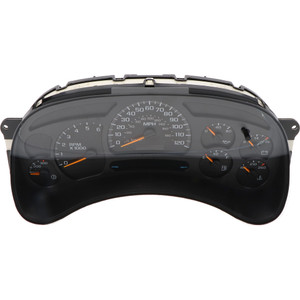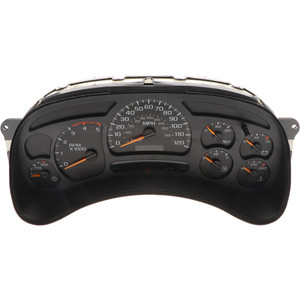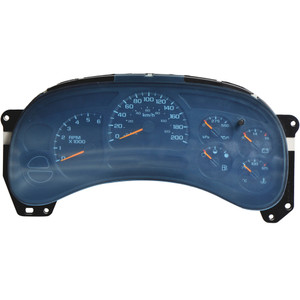Product Description
CARDONE leverages extensive experience with many of the most critical automotive electronics systems to expertly re-engineer instrument clusters to the highest quality standards. Critical components are 100% replaced and tested for accurate calibration and reliable performance. A showroom-new look is achieved by restoring or replacing lens assemblies with new polycarbonate. Every unit comes preprogrammed with VIN, mileage and engine hours, if applicable, to minimize downtime and get the vehicle back on the road quickly.
Lens assemblies are restored to like-new quality or replaced with new polycarbonate material to improve visibility and provide that showroom look to the dashboard.
Halogen bulbs are 100% replaced, while LED bulbs are tested and replaced as needed to maintain proper function of the warning light system.
All gear-driven stepper motors are replaced with upgraded units to ensure long life.
Gauge needles are calibrated for proper operation.
Segments or display panels are validated and tested to ensure proper function.
As a remanufactured Original Equipment part, this unit guarantees a perfect vehicle fit.
Our remanufacturing process is earth-friendly, as it reduces the energy and raw material needed to make a new part by 80%.
Complete the Check It Fits tool and confirm all information in the Fitment Details section above to ensure
you select the right part for your application.
Product & Technical
What type of repairs do you perform?
All stepper motors and halogen bulbs are 100% replaced. LEDs that do not function are replaced. Any faulty circuit board components are replaced as necessary, including the connector blocks and driver information center displays. We restore the lens assembly to a like-new condition or replace it with a new lens if that is not possible.
How is the IPC cleaned?
The IPC is disassembled 100%. Boards are hand cleaned with alcohol, and outer cases are batch washed.
Do you remanufacture instrument panel clusters (IPCs) with digital displays or just ones with analog gauges?
Currently, we only remanufacture IPCs with analog gauges and integrated driver information centers, if equipped.
Is any vehicle-specific Flash programming required?
Yes. The latest service calibration is Flashed into the IPC at the factory using using an OEM tool and scanner.
Is there any on-car programming or a relearn procedure that must be performed after installation?
On-car programming or relearning is not necessary on IPCs with analog gauges.
Is there any on-car programming or a relearn procedure that must be performed after installation?
On-car programming or relearning is not necessary on IPCs with analog gauges.
Do I have the option of buying the cluster without programming?
Currently, purchasing IPCs without programming is not an option. In the future, we hope to offer a remote programming plan.
Is the odometer reset at the factory, or does the IPC have to go back to the dealership to set the odometer?
The odometer is reset at the factory based on a signed affidavit from the consumer that confirms the VIN, mileage and engine hours.
How is the IPC tested?
Each unit is connected to a vehicle simulator that checks all functions. All gauges are tested at various levels of input to make sure they are calibrated, and the output is correct. All indicator signals are simulated to make sure the cluster displays the appropriate message or warning. All driver information display functions are tested for readability. Finally, the gear selector is checked to ensure it illuminates properly for all gears.
What are the common failure modes you see?
There are a few different categories of problems that we see: 1) The unit’s gauges do not function properly relative to inputs from the vehicle. 2) The indicator lights do not illuminate properly, if at all. 3) The lens assemblies have been damaged or broken so that visibility is reduced. 4) The units will not power on or function.
How is the IPC inspected?
IPC printed circuit boards are 100% inspected using a vision system under magnification to detect trace erosions, poor solder points, and surface mount or thru-hole component failure.
What info do I need to order?
Accurate VIN, mileage are required and engine hours are optional.
Core
What is a core?
A core is a used automotive part that is returned to the remanufacturer instead of being scrapped.
Why return cores?
Cores are literally at the “core” of the remanufacturing process, because they are the raw material used to
start the remanufacturing process. That’s why remanufacturers buy cores back from customers, and they pay
the most for good quality cores. If a core has too much damage in key areas, it may be unusable or require
extra resources to process; therefore a reduced core payment may be awarded. This core policy explains
potential deductions that may be taken from the core price if certain components are missing or damaged.
What is remanufacturing?
Remanufacturing is the process of taking used parts, completely disassembling and thoroughly cleaning them,
replacing the worn components with original quality components, and restoring them to their original
function. Every unit is 100% tested to ensure O.E. performance.
Why “reman”?
PRODUCTS -
Reman captures used, durable goods like auto parts and puts them “back on the road” to new and sometimes
better than new performance. Reman provides the opportunity for detection of common failure modes and
incorporation of design improvements to prevent repeat failure.
ECONOMY -
Reman products cost consumers about 40% less than new. Reman products are one of the few “green” products
that actually costs less than their “non-green” counterparts.
ENVIRONMENTAL -
Reman saves up to 86% of the energy required to build a new unit. Reman realizes Greenhouse Gas savings of
up to 25 lbs. per unit over new. Reman saves up to 85% of the raw material required to produce a new unit by
reusing existing products. Reman is even more sustainable than recycling, as product castings are preserved
rather than melted down to raw material, saving energy and reducing emissions.
 Remanufactured products only require 15-20% of the total energy and material it takes to manufacture
new parts while keeping usable cores out of landfills.
Remanufactured products only require 15-20% of the total energy and material it takes to manufacture
new parts while keeping usable cores out of landfills.
 CARDONE's skilled technicians and engineers can completely rebuild your part and return it to you,
good as new. Learn More.
CARDONE's skilled technicians and engineers can completely rebuild your part and return it to you,
good as new. Learn More.














